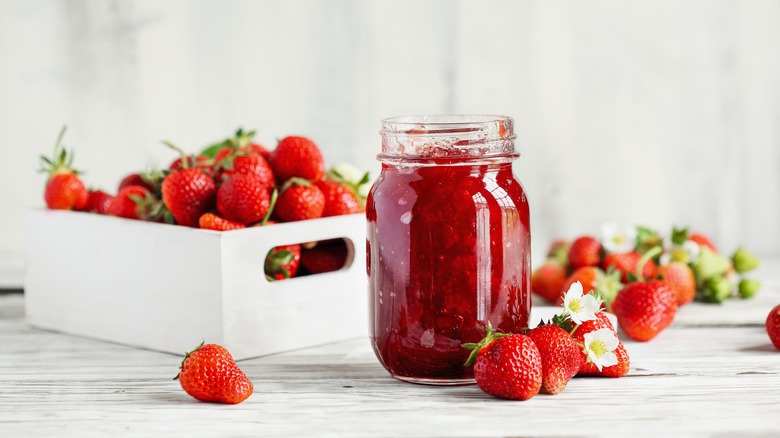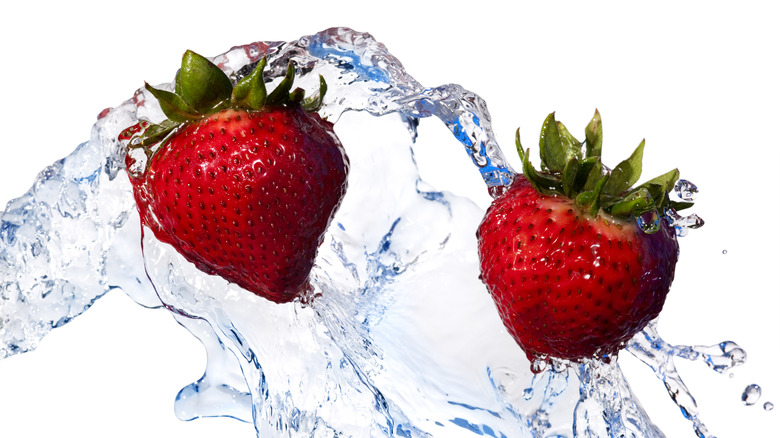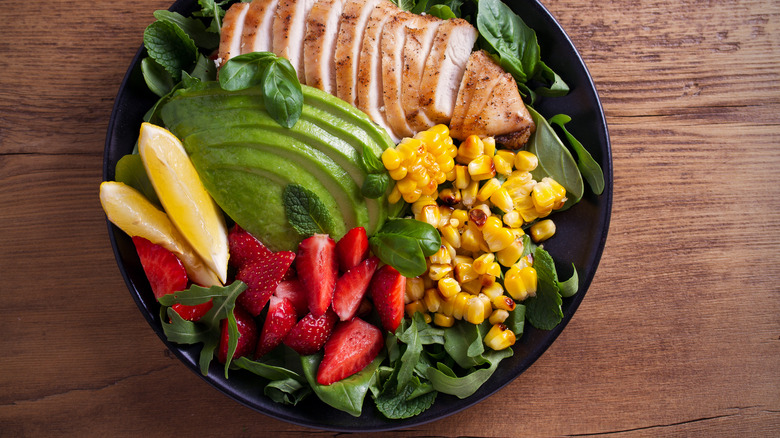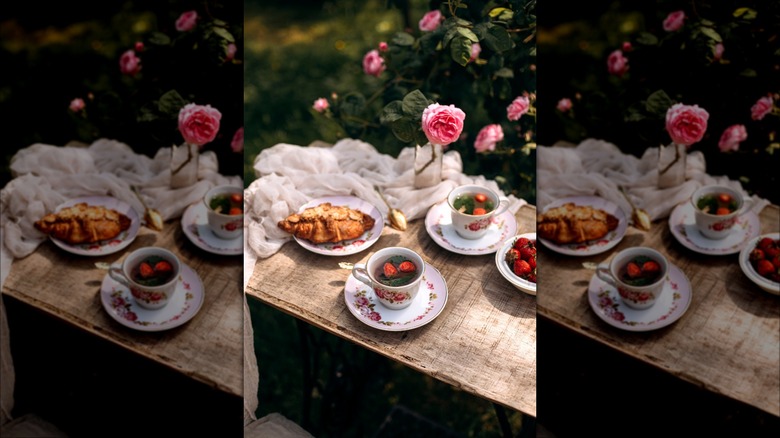Strawberry Hacks You'll Wish You Knew Sooner
If you want to know how much people in the United States love strawberries, just look to California. Although strawberries grow in every state, California is king when it comes to strawberry crops. Three billion pounds of strawberries come out of the Golden State alone each year. And as far as fruit crops go, the strawberry stands just a little behind bananas, apples, and grapes as the most consumed fruit. In other words, people like strawberries a whole bunch.
However, strawberries used to be a luxury — not a garden and supermarket regularity like they are today. They grew wild for centuries until the French began planting them in the 1300s. The strawberry has undergone many changes since then and has inspired not only recipes galore but also events like strawberry festivals from California to Florida.
Despite the ubiquity of strawberries in the modern world, however, many food nerds haven't learned to really take advantage of all of the goodness that strawberries have to offer. Fortunately, this is the age of the internet, and those not in the know of said strawberry hacks can find some cool ones with just the click of a mouse or the touch of a button. While it would be impossible to include them all in one article, these hacks count among the best you'll find anywhere, ripe and ready for the proverbial picking.
Sealing strawberries in a jar extends their lives
Mason jars aren't just for storing strawberry jams and preserves. There's a certain strawberry hack that allows you to save your fresh strawberries in the jar of your choice for up to three weeks. If you've ever purchased a carton of strawberries and had them go bad before you got home about five minutes after you got home from the grocery store, employing this simple trick might ensure it never happens again.
All it takes is a jar with a lid and some water into which you plop your berries. Proponents of this method say that strawberries can last for up to three weeks using this preservation method. That said, some adopters of this hack aren't so enthusiastic about having a jar of water filled with strawberries in the fridge. Those who believe that strawberries shouldn't be stored in water advocate patting the strawberries dry and putting them in a sealed mason jar. If you opt for this method, don't wash the strawberries until you're ready to use them.
The one element that all seem to agree on is the sealed jar. That being the case, there is an argument for trying this hack both ways. That is to say, you may want to try storing the strawberries in a jar in water and then going without the water and see which works better.
Straws make hulling strawberries easier
In an ideal world, removing that little cluster of leaves on the top of the strawberry doesn't need to mean wasting a lot of the strawberry. Often, this is the case because many people just slice off the frill of leaves at the top of the strawberry as well as some of the flesh along with it. If you hate the idea of wasting all that food, a solution is as close as your McDonald's Coca-Cola cup. The straw that brings that makes McDonald's Coke taste so good also works surprisingly well when you need to remove the stems of your strawberries.
To employ this hack, press one end of the straw into the bottom of the strawberry. Thread it all the way through until it hits the stem part of the leaves. Twist the straw around a little bit to cut around the stemmy hull, and then push the straw the remainder of the way through the berry, as if you are threading the strawberry on a necklace made of drinking straw. Once the straw is pushed through the berry, the green frill of leaves will be on the end of the straw and no longer on the strawberry. And best of all, no wasted berry.
White vinegar puts the kibosh on mold growth
If you're not careful, mold will eat your strawberries faster than you can. However, this doesn't mean that you need to lay out a checkered picnic blanket for the molds that want to eat your berries. There is a simple yet effective solution, and best of all, it's probably already in your cupboard. Believe it or not, it's white vinegar, that ingredient that gives your sweet and sour chicken recipe its sour taste.
When you try this hack, you don't want to pickle the strawberries, however. You'll need to dilute the vinegar a bit. Make a 10-to-1 ratio of water to vinegar. When utilizing this trick, it's not necessary to wash the berries first. The vinegar water will do that. Just make up the vinegar water and plop the berries into it for five minutes or so. Any mold that has started to grow will go the way of the dinosaurs.
For extra added insurance, dig out your baking soda, too. If you're using both baking soda and vinegar, place the strawberries in a clean bowl, sprinkle a teaspoon or so of baking soda all over the strawberries, kind of like you're sprinkling sugar on cereal, and then pour the vinegar water in. The mixture will bubble and boil for a bit, leaving you with clean strawberries on the other side of the process. Leave them on a napkin or dish towel for about 20 minutes to dry off.
Soaking in water perks them up and cleans them off
While ice and ice packs might make the bags under your eyes a little less perky, those frozen chill-fests do the opposite for your drooping strawberries. Even better, it doesn't take much to make this simple trick an impressive part of your strawberry prep. To start, get out a glass bowl and fill it with water. Add in lots of ice cubes but don't skimp on the water. You can give the berries a quick rinse to get rid of any dirt that might be on them, but otherwise, they should be good to go.
Once your water is chilled and the strawberries are prepped, put your mushy, slightly wilted strawberries in the water and allow them to soak in an ice bath for about 20 minutes. Strawberries, really any berries, have a lot of pores in them. The ice water seeps into the pores and perks them back up.
Soaking also works if you're looking to ensure your strawberries are free of dirt and bugs. Use about a teaspoon of salt for every cup of water and soak the berries for a few minutes as the mixture cools. Any sort of microscopic insects or hidden dirt will be drawn out, leaving you with clean, delicious strawberries ready to eat after a simple pat dry.
Try savory strawberry recipes to expand your recipe repertoire
When it comes time to add a little sweetness to your savory, you have the usual suspects. You can add a little sugar to your tomato sauce, a little pineapple and orange to your sweet and sour, and a few strawberries to just about anything you'd like. What? You've never heard of adding strawberries to a savory dish? Or maybe you have, but you limit yourself only to the strawberry vinaigrette that you put on your salad. Either way, you're cheating yourself out of some really amazing flavors that can turn run-of-the-mill dishes like barbecue chicken into something for the books.
Experienced cooks understand that there are five flavors, which include sour, salty, bitter, umami, and sweet, and they will often try to add as many flavors as they can to a dish. Doing this makes for a more interesting flavor profile in recipes. If you'd like to try this with strawberries to make a savory dish a little sweeter but you're concerned about not liking the combo, start with some side dishes or appetizers first. For example, top some bruschetta with some brie and strawberries, or make a strawberry salsa for your chips. This allows you to use up some of the strawberries during strawberry season without committing a whole dinner to a dish you may not like. Once you're feeling a bit braver, move on to recipes like barbecued chicken with strawberry barbecue sauce.
The blender turns your berries into ice cubes
If you have a party coming up, don't serve the same old ice cubes with your drinks. Jazz up drink recipes like mimosas and party punch with strawberry ice cubes. Making them is simple, and it only requires a couple of ingredients and a few minutes of your time.
Once you wash and hull your strawberries, drop them into your blender. Add in the juice of your choice. Orange juice offers a good option, but you're not limited to that. For example, banana and orange, pomegranate, and even apple juice would work. Blend up the concoction as if you were making a strawberry smoothie.
Pour the strawberry smoothie mixture into your ice trays, and freeze the trays until strawberry ice cubes form. Come party time, toss your strawberry ice cubes into your drink recipes to add a chilled, fruity flair. Fruit punch and mimosas for your favorite crowd of friends have never tasted quite so yummy.
Sparkle strawberries take freezer jam to the next level
There's no rule that says you have to make strawberry freezer jam with Sparkle variety strawberries, but given that this variety of strawberry is looked to as one of the best strawberries for making your berry-flavored toast spread, you might want to try it at least once. Generally speaking, strawberries bloom in the early part of the late spring/ early summer growing season. The Sparkle strawberry is a late bloomer as far as strawberries go, so if you've begun putting aside some strawberry jam recipes for the coming winter, this strawberry is an excellent choice for those jams.
It's also a strawberry that's worth waiting for. When the strawberry ripens, it comes out plump and juicy on the other side of the growing season and sports a brilliant red color. It's the kind of red that Christmas outfits are made for, and if you're of the mind to save your strawberry jam for the fall and winter holidays, this strawberry comes dressed for the occasion. It's the sparkle in the Season of Giving.
Strawberries perk up vegetable platters
Charcuterie platters, those amalgamations of sliced cheeses, cured meats, crisp seasonal vegetables, pickles, and succulent fruit, including strawberries, have enjoyed wide popularity in recent years, particularly at parties. Nearly 80% of consumers have tried them and have admitted to either liking them or loving them, according to the Web Restaurant Store. Aside from being easy to make yourself if you're so inclined, they're another meal option that includes pretty much all of the five tastes, so they're satisfying for the palate as well.
And while other treats like bananas, dried dates, or figs could add some sweet elements to your platter, there's an argument to be made for putting strawberries on your next charcuterie board. For one thing, if you plan on serving wine, particularly a sparkling wine like Champagne or its Italian equivalent, Prosecco, strawberries are a go-to fruit for this. Many of the other ingredients on the board, like Brie and crackers, also go well with wine making this a logical fruit around which you can build the fruit portion of your charcuterie platter.
Aside from this, strawberries are among the world's most popular fruits. Per Fresh Produce, 71% of people say that they count strawberries among their favorites, which means that if you put them on your platter, most people at your party will eat them. In other words, there'll be no wasted food after the party's over.
Growing your own berries from the fruit is possible
Usually, home gardeners plant their strawberries from plants that they get at the home and garden store. However, strawberries can be grown from strawberry fruits, which are just basically little fleshy seed pods. While other methods of growing strawberries offer you plenty of advantages, this one is unique in that you're growing strawberries that you know you'll like. In other words, this is one way to ensure that your favorite strawberry varieties grow in your garden. By extension, you won't have to worry about finding the right strawberry plants at the home and garden store. You already have them. You had them for dessert after dinner just this evening (or whenever).
To grow your strawberries from the berry, put your strawberries in the blender on a low setting. After that, pour the pulverized berries into a sieve and rinse the contents out until you are left with the seeds. Allow the seeds to thoroughly dry in a coffee filter for a couple of weeks.
There's one more important thing to note before you plant your seeds. As a plant species, strawberries "expect" a little bit of a cold snap before they grow. In natural settings, the cold snap comes from winter. You're going to have to give them that artificially by putting the seeds in a bag and then storing it in your freezer for up to six weeks. Once your strawberry seeds warm up to room temperature, plant them in mini containers before transplanting them into your garden.
Timing is the key to chocolate-covered strawberries
When you are making chocolate-covered strawberries, time is of the essence. Chocolate-covered strawberries are not something that you can make ahead of time and hope they turn out well. If you're having a party, for example, then plan on making the strawberries the same day of the party, the closer to the start time of the party, the better. Chocolate-covered strawberries that you store in the fridge tend to get mushy very quickly. It seems counterintuitive, but after an initial firming up of the chocolate in the fridge, the chocolate-covered strawberries can be removed from the fridge. They don't need to be chilled any longer.
The other related tip to this equation might seem obvious. Start with the freshest, plumpest strawberries possible. Use quality baking chocolate as well, which you'll melt on low heat, either in the microwave or on the stovetop in a double-broiler. Burnt chocolate is a no-no here. Once you dip the strawberries into the chocolate, allow them to sit out at room temperature on a sheet of parchment paper. After that, put them in the refrigerator, but only for 30 minutes or less, to allow the chocolate to set. Serve them soon after that.
The sweetest strawberries are in June
For those of us who watch the buds on the trees in eager anticipation for the coming spring, there are a few plants that are the proverbial weathervane of the time. In the flowering shrub world, it's usually forsythia or lilacs, and in the fruit world, it's the strawberry in most places. Naturally, berries and other fruits grow at the speeds that their individual climates allow for. In other words, strawberries in Florida bloom sooner than strawberries in Idaho do, so the strawberry season can be slightly different depending on where you are.
But if you are looking for the best-tasting strawberries that you're going to find for the whole season, look for strawberries in the store or at the farmers' markets in June. Berries, in general, are a little bit fragile. The heat of the summer can make them wilt. While it's true that some varieties are hardier and will grow later into the season, you should expect to pick up strawberries for recipes like freezer jam and other canned items in June just to be safe. The summer's sweetness will be captured in your recipes if you follow this plan.
The strawberry's flavor works well with rose tea
Rose herbal tea is a delicate yet fragrant addition to an afternoon tea party. Its flavor hints at the scent of roses growing in the garden in the heat of spring. And while rose tea has such a refined taste that you can drink it without anything else in it, you can make it more flavorful without overpowering it by adding strawberries to your tea. Aside from the fact that strawberries themselves have a delicate flavor and constitution, there's another reason why they work so well with rose tea. Both plants belong to the Rosaceae family. Botanically speaking, that makes them cousins.
As far as serving strawberries in your rose tea goes, you can do something as simple as washing some berries and dropping them directly into the tea. However, you also have the option of chopping the berries up a little bit in the blender and allowing them to infuse the tea with their flavor. This tea also tastes refreshing on ice as well if you're looking for a tea to drink on a hot day, and the fresh strawberries add a particular hint of freshness to the concoction. If strawberries aren't in season, buy rose tea with dried chunks of strawberry in it. This allows you to bring a little spring freshness to your afternoon, whether it's early spring or early winter.












